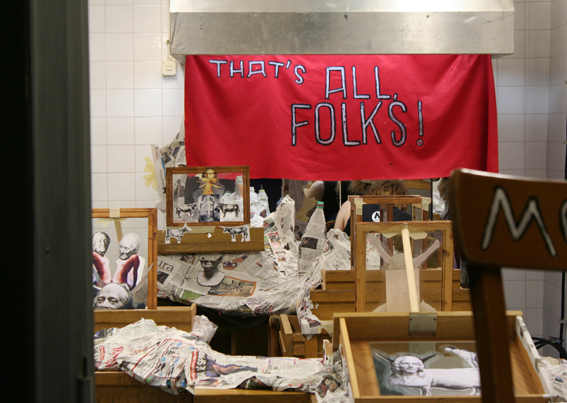In transitional landscapes, which we understand as zones of severe turmoil, spatial changes take place. In this course we will research and discuss these changes. Furthermore, we will examine specific forms of art and architecture, evoked by political and ecological transformations. These diverse spatial dynamics will be critically reflected. Within this context, students will choose a topic on which to write a scientific seminar paper. Thereby, different transdisciplinary methods and art-based research will be tested.
Art in Transitional Landscapes: Art Biennial in a military command centre, memory-scapes in zones of nature preservation, escape routes in the EU borderlands.

OSLOBOÐENJE: the burlesque museum, 2015, Nikolay Oleynikov Photo: ©Karin Reisinger
Diverse practices, applied by various actors, emerge as reactions to the dynamics of changing political and ecological landscapes. We will observe the impact of these practices while exploring the position of the arts and their effect on transitional landscapes. These observations were partially evoked by an excursion to the Art Biennial in Konjic in the summer term of 2015. What kind of new space emerges when artists, activists and the military share responsibility for a Biennial? Which forms of collaboration determine the complex landscape?
The command centre assumes different roles: it becomes a stage for methods of colonisation; a place for working and the presentation of selected artworks; a laboratory for artists and curators; an everyday space for soldiers; a space of exception for international visitors; and an uninteresting space for the inhabitants of the nearby city Konjic.
Further current examples are transitions in the ecosystem, which force ecological modes of thought upon artists and architects, or the current streams of fleeing people and constructional and structural reactions at the EU borders. As a consequence of various contemporary events, which determine the working environments of architects and artists, this seminar connects chosen ecological and political changes with current spatial phenomena. It is inevitable that attention will be channelled on the spaces in-between, inside, as well as outside the (cultural, national, political...) borders.
The main components of the seminar are research camp, drawing text and writing studio. Different ways of transferring and sharing ideas will be explored.
Concept:
Karin Reisinger and Amila Sirbegovic
Literaturbeispiele:
Agamben, Giorgio. Homo sacer: Die souveräne Macht und das nackte Leben. Frankfurt am Main: edition suhrkamp, 2002.
Easterling, Keller. „Die Aktion ist die Form/The Action is the Form.“ Dérive 40 (2010): 25-28.
Klein, Naomi. This Changes Everything. Penguin Books, 2014.
Krasny, Elke und Irene Nierhaus (Hrsg.). Urbanografien, Stadtforschung in Kunst, Architektur und Theorie. Berlin: Reimer Verlag GmbH, 2008.
Latour, Bruno und Sciences Po. Waiting for Gaia: Composing the Common World Through Arts and Politics. Vorlesung am French Institute, SPEAP London: November 2011, http://www.bruno-latour.fr/sites/default/files/124-GAIA-LONDON-SPEAP_0.pdf (01.09.2015).
Mitchell, W.J.T. (Hrsg.). Landscape and Power. Chicago: University of Chicago Press, 2002.
Uexküll, Jakov von. „An Introduction to Umwelt.“ In Space Reader, hrsg. Von Michael Hensel, Christopher Hight und Achim Menges,145-148. Chichester: Wiley, 2009.
Vassileva, Maria (Hrsg.). Art for Change 1985-2015. Sofia: Sofia Art Gallery, 2015.